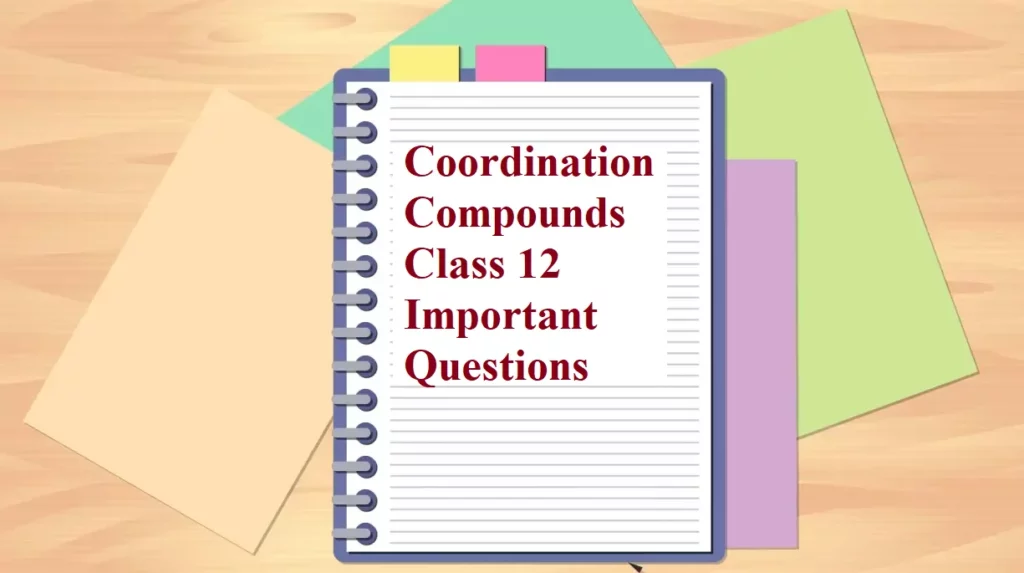Coordination Compounds Class 12 Important Questions
Que 1. Identify the complexion and counter ion in K4[Fe(CN)6].
Ans 1. [Fe(CN)6]4– and K+ respectively.
Que 2. What is ambidentate ligand? Give one example.
Ans 2. Monodentate ligands contain more than one coordinating atom. Example, CN−.
Que 3. How many geometrical isomers are possible in the following coordination entities: [Cr(C2O4)3]3– [CoCI3(NH3)3].
Ans 3. (i) C2O4 is a bidentate ligand. So no geometrical isomers possible.
(ii) Two two geometrical isomers are possible (fac‐and mer‐isomer).

Coordination Compounds Class 12 Important Questions
Que 4. What is meant by the denticity of a ligand? Give examples of a unidentate and a bidentate ligand.
Ans 4. Denticity indicates the number of donor sites in a ligand. It can be 1, 2, 3, 4, and 6 for unidentate, bidentate, terdentate, tetradentate, and hexadentate ligands respectively. Unidentate ligands: Cl, H2O, NH3, Bidentate ligands: Ethylenediamine, Propylene, diamine.
Que 5. The magnetic moment of [MnBr4]2– is 5.9 B.M. What is the geometry of this complexion?
Ans 5. The magnetic moment is 5.9BM means unpaired electrons are 5. Bromine is a type of weak field ligand, so back pairing will not occur. So, the geometry of the compound is tetrahedral and hybridization is sp3.
Que 6. Write coordination number of central metal atom in [Pt(en)2Cl2].
Ans 6. Coordination No – 6
Que 7. Write the IUPAC name of [PtCl2(en)2(NO3)2].
Ans 7. Dichloridobis(ethylenediammine)nitratoplatinum(IV).
Que 8. Why does ammonia readily form complex while ammonium ion does not?
Ans 8. Ammonium ion (NH4)+ neither has lone pair of electrons nor a vacant orbital.
Que 9. Define coordination polyhedron.
Ans 9. The spatial arrangement of the ligand with the central metal ion to give a definite geometry.

Coordination Compounds Class 12 Important Questions
Que 10. CuSO4.5H2O is blue in color white CuSO4 is colorless. Why?
Ans 10. d‐d Transition is possible in CuSO4.5H2O, so it shows Color. CuSO4 due to the absence of water (ligand) CFT is not – possible, it is so colored.
Que 11. Although NH2·NH2 possesses two electron pairs for donation, it does not act as a chelating agent. Why?
Ans 11. The coordination by NH2·NH2 leads to a three-member strained ring which is highly unstable and hence it does not act as a chelating agent.
Que 12. When a coordination compound CrCl3.6H2O is mixed with AgNO3, 2 moles of AgCl are precipitated per mole of the compound. Write structural formula & IUPAC name of the complex.
Ans 12. There are three compounds with the formula
CrCl3.6H2O. One is violet, one is grey-green, and the third is deep green.
The violet isomer produces 3 moles of silver chloride upon reaction with silver nitrate and does not lose water in a desiccator.
[Cr(H2O)6]Cl3 (violet)
The grey-green isomer gives 2 moles of silver chloride upon reaction with silver nitrate and loses one mole of water when stored in a desiccator.
[Cr(H2O)5Cl]Cl2.H2O (grey-green)
The deep green isomer gives 1 mole of silver chloride upon reaction with silver nitrate and loses two moles of water when stored in a desiccator.
[Cr(H2O)4Cl2]Cl.2H2O (deep green)
(i) The given compound has a structural formula O)5Cl]Cl2.H2O
(ii) The IUPAC name of the complex is
Que 13. An aqueous solution of potassium ferrocyanide does not give the test of iron(II) and it is not poisonous like potassium cyanide. Why?
Ans 13. Being a complex salt, it ionizes to 4K+ and [Fe(CN)6]4– ions. The absence of Fe(II) does not give the test of iron. The absence of free CN– makes it non-poisonous.
Que 14. Calculate the magnetic moments of the following complexes:
(i) [Fe(CN)6]−4 (ii) [FeF6]−3
Ans 14. (i) Fe+2 → 3d6
CN− is a strong ligand so e− pair 4p, no unpaired e− then the magnetic moment is zero.

Coordination Compounds Class 12 Important Questions
Que 15. A solution of [Ni(H2O)6]2+ is green, but a solution of [Ni(CN)4]2- is colourless. Explain.
Ans 15. In [Ni(H2O)6]2+, Ni is in a +2 state with the configuration 3d8, i.e., it has two unpaired electrons which do not pair up in the presence of the weak H2O ligand. Hence, it is coloured. For d–d transition, red light is absorbed and complimentary light emitted is green. In the case of [Ni(CN)4]2–, Ni is again in +2 state with the configuration 3d8 but in presence of the strong CN– ligand, the two unpaired electrons in the 3d orbitals pair up. Thus, there is no unpaired electron present. Hence, it is colourless.
Que 16. Write the IUPAC names of the following coordination compounds:
(A) [Pt (NH3)2Cl(NO2)]
(B) K3[Cr(C2O4)3]
(C) [CoCl2(en)2]Cl
(D) [Co(NH3)5(CO3)]Cl
(E) Hg[Co(SCN)4]
(F) [Ni(CO)4]
Ans 16. (A) Diamminechloridonitrito-N-platinum (II)
(B) Potassium trioxalatochromate (III)
(C) Dichloridobis(ethane-1, 2-diamine)cobalt (III) chloride
(D) Pentaamminecarbonatocobalt(III) chloride
(E) Mercury tetrathiocyanatocobaltate(III)
(F) Tetracarbonylnickel(0)
Que 17. Draw a figure to show the splitting of d orbitals in an octahedral crystal field.
Ans 17.
Coordination Compounds Class 12 Important Questions
Que 18. Explain inner & outer orbital complex using suitable examples.
Ans 18. The main difference between inner and outer orbital complexes is that the hybridization of the atomic orbitals of the central metal atom of the inner orbital complex involves inner shell d orbitals whereas the hybridization of the atomic orbitals of the central metal atom of the outer orbital complex involves outermost shell d orbital.
Que 19. On the basis of VBT, explain geometry, nature of hybridization, and magnetic property of [Co(ox)3]3–.
Ans 19. Hybridisation – sp3d2 Geometry – octahedral Paramagnetic in nature due to the presence of four unpaired electrons.
Que 20. Mention the main postulates of Werner’s theory.
Ans 20. (i) Metal ion has two types of valency.
(ii) Primary valency and secondary valency.
(iii)Secondary valency is equal to coordination number.
Coordination Compounds Class 12 Important Questions




